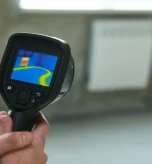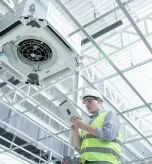Water leaks inside walls, roofs, or underground can be hard to spot, especially without visible damage. Thankfully, modern technology like infrared and thermal imaging makes building water leak detection faster and more accurate. This guide explains how these cameras work, why they’re effective, and how they compare to other methods.
Understanding Infrared and Thermal Cameras
Infrared and thermal cameras don’t detect water directly. Instead, they capture differences in surface temperature. When a water leak occurs, the affected area often becomes cooler due to evaporation or water absorption. Thermal cameras convert these temperature differences into color-coded heat maps, highlighting anomalies that may indicate leaks.
Read More: Thermal Imaging in Home Inspections: Benefits & Limitations
Key Features of Infrared and Thermal Cameras
- Detect subtle temperature changes that reveal the presence of moisture.
- Highlight cooler or warmer zones based on how water affects thermal conductivity.
- Provide visual heat maps for easy analysis by inspectors.
These devices are ideal for identifying leaks behind walls, under floors, and above ceilings without invasive drilling or cutting.
How Thermal Imaging Detects Water in Walls?
When there’s a leak behind drywall, the moisture spreads and cools the surrounding materials. This temperature change is visible through thermal imaging.
How it works:
- A leak causes water to saturate insulation or wallboard.
- The moisture cools the area as it evaporates.
- A thermal camera reveals a temperature anomaly—usually a cooler region.
- The inspector investigates the location for further confirmation using moisture meters.
This non-invasive process allows homeowners and professionals to detect water in walls without tearing down sections blindly.
Using Infrared to Find Roof Leaks
Thermal cameras are highly effective for identifying roof leaks. During the day, roofing materials absorb sunlight and heat. At night, dry areas cool faster than wet ones, which retain heat. This difference is where thermal imaging proves helpful.
- Wet insulation holds heat longer.
- Thermal cameras detect the retained heat in a warmer zone.
- Inspectors use this data to locate roof leak sources beneath surface materials.
This method is especially useful after storms or during regular building inspections.
Detecting Underground Water Leaks
Underground leaks can be challenging to detect. However, thermal imaging may identify shallow leaks by sensing cooler soil temperatures. Water conducts heat differently than dry soil, creating thermal anomalies.
For deeper leaks, professionals may use:
- Ultrasonic water leak detectors listen for escaping water sounds.
- Ground microphones to locate pipe bursts.
- Pressure testing to confirm the presence of a leak.
DIY users sometimes try to make their own underground water leak detectors. However, these tools are often not as accurate or reliable as professional equipment.
Leak Detection Methods Comparison
| Method | Wall Detection | Roof Leaks | Underground Leaks | Invasive? | Accuracy |
| Thermal Imaging Camera | Yes | Yes | Shallow only | No | High |
| Ultrasonic Water Leak Detector | Limited | No | Yes | No | Medium |
| Manual Inspection | Sometimes | Rarely | Rarely | Yes | Low |
| DIY Tools (e.g., stethoscope) | Unreliable | No | Possibly shallow | Yes | Very Low |
Benefits of Thermal Imaging for Leak Detection
Thermal cameras are preferred for leak detection because of several key advantages:
- Non-invasive inspections: Avoids damaging walls or floors.
- Time-efficient: Quickly scans large areas.
- Cost-effective: Reduces guesswork and unnecessary repairs.
- Accurate targeting: Helps pinpoint leaks for precise repair.
- Prevents mold: Early detection prevents moisture from spreading and causing mold growth.
Thermal imaging to detect water leaks is a smart preventive step for homeowners and property managers alike.
When to Use Thermal Leak Detection?
Thermal imaging should be used when:
- You notice high water bills with no visible leaks.
- Musty smells or signs of hidden dampness exist.
- Mold or mildew begins to appear.
- Paint or wallpaper is bubbling or cracking.
- You want to inspect after a flood or heavy rain.
In these cases, using a thermal camera for water leaks can help detect hidden damage early.
DIY vs. Professional Leak Detection
While some affordable thermal cameras are available for home use, they lack the resolution and accuracy of professional equipment. Here’s a breakdown:
DIY Detection
- Tools: Inexpensive thermal cameras or apps.
- Advantages: Accessible and budget-friendly.
- Limitations: Lower resolution and no moisture confirmation.
Professional Detection
- Tools: High-grade thermal imaging cameras, moisture meters, and ultrasonic detectors.
- Advantages: Accurate diagnostics and expert interpretation.
- Limitations: Higher cost, but worth it to avoid further damage.
If you want to find water leaks in walls, roofs, or floors, professionals have better tools and skills.
Infrared vs. Thermal – Is There a Difference?
Technically, yes:
- Infrared camera: Any device that senses infrared radiation (heat).
- Thermal imaging camera: A type of infrared camera designed to create images from temperature differences.
In practice, people use both terms interchangeably when discussing water leak detection.
Read More: Top Things to Look for in a Condo Home Inspection
Reading Thermal Images to Identify Leaks
A trained technician can interpret thermal images to find leaks effectively. Moisture patterns appear as follows:
- Cooler areas (blue/purple): Indicates wet or damp spots.
- Warmer areas (yellow/red): Usually dry regions.
- Anomalous patterns: Suggest irregular moisture build-up or pipe leaks.
Professionals often verify findings using moisture meters or visual inspections.
Signs of Hidden Water Leaks
Leaks don’t always show obvious symptoms. Look out for:
- Warped walls or flooring
- Bubbling paint or wallpaper
- Faint odors of mold or mildew
- Persistent damp areas
- Sounds of running water with no source
These may all signal the need for thermal imaging leak detection.
FAQs
1. Can a thermal camera detect water inside walls?
Yes. A thermal camera detects changes in surface temperature caused by moisture inside walls. It doesn’t see the water directly, but it visualizes the cooling effect that water has on surrounding materials. This allows inspectors to identify wet areas quickly and non-destructively.
2. Are thermal cameras really accurate for finding leaks?
They are exceptionally accurate when used by trained professionals. Thermal cameras show temperature differences caused by water. When used with moisture meters, they give reliable confirmation. However, environmental conditions can sometimes affect accuracy.
3. Will insulation in the wall affect thermal imaging?
Yes, insulation can impact how well a thermal camera detects leaks. Some insulation materials may mask or reduce the temperature difference. Despite this, experienced inspectors know how to work around these limitations and can still identify problem areas effectively.
4. Is thermal imaging entirely safe for use in homes?
Absolutely. Thermal imaging is non-invasive and emits no radiation. It simply reads heat from surfaces, similar to how a digital thermometer works. No health risks are involved for people or pets during the inspection.
5. How much does it cost to have a thermal leak inspection done?
Costs vary based on the size of the property and the region. In Riverside, California, a typical thermal water leak inspection might cost between $200 and $400. A cost-effective investment can prevent more expensive repairs by catching issues early.
Conclusion
Water leaks can cause significant damage when left undetected, especially when hidden in walls, under floors, or above ceilings. Using tools like infrared and thermal cameras helps property owners find and fix leaks early. This prevents structural damage and mold growth.
If you want to find roof leaks, thermal imaging is a good option. It can also help detect water leaks in walls. Additionally, it can spot moisture underground. Thermal imaging is quick, safe, and reliable. It also complements other techniques like ultrasonic leak detection and moisture measurement tools.
If you suspect a hidden leak, don’t wait for visible damage to appear. Contact a trusted professional to explore the benefits of thermal imaging for water leak detection.
Are You Looking for Reliable Inspection Services?
We provide professional property inspection services across Riverside, California, and surrounding areas. Whether you’re buying, selling, or maintaining a property, our expert team is here to help. We proudly serve clients in the following locations:
| Agoura Hills | Alhambra | Arcadia | Artesia | Avalon | San Marino |
| Azusa | Baldwin Park | Bell | Bellflower | Bell Gardens | Signal Hill |
| Beverly Hills | Bradbury | Burbank | Calabasas | Carson | Torrance |
| Cerritos | City of Industry | Claremont | Commerce | Compton | Santa Clarita |
| Covina | Culver City | Diamond Bar | Downey | Duarte | South El Monte |
| El Monte | El Segundo | Gardena | Glendale | Glendora | Vernon |
| Hawaiian Gardens | Hawthorne | Hermosa Beach | Hidden Hills | Huntington Park | Santa Fe Springs |
| Inglewood | Irwindale | La Cañada Flintridge | La Habra Heights | Lakewood | South Gate |
| La Mirada | Lancaster | La Puente | La Verne | Lawndale | Walnut |
| Lomita | Long Beach | Los Angeles | Lynwood | Malibu | Santa Monica |
| Manhattan Beach | Maywood | Monrovia | Montebello | Monterey Park | South Pasadena |
| Norwalk | Palmdale | Palos Verdes Estates | Paramount | Pasadena | West Covina |
| Pico Rivera | Pomona | Rancho Palos Verdes | Redondo Beach | Rolling Hills | Sierra Madre |
| Rolling Hills Estates | Rosemead | San Dimas | San Fernando | San Gabriel | Temple City |
No matter where you’re located within these areas, our inspection experts are ready to assist you. Reach out today to schedule your inspection!





